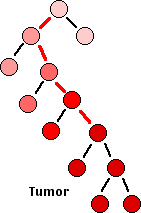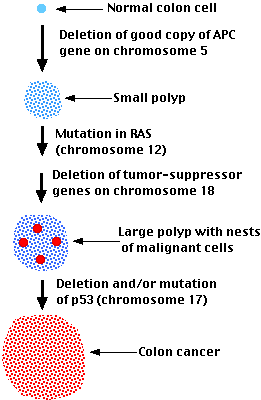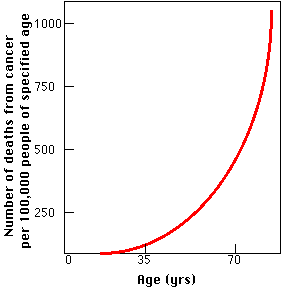A cancer is an uncontrolled proliferation of cells.
- In some the rate is fast; in others, slow; but in all cancers the cells never stop dividing.
- This distinguishes cancers — malign tumors or malignancies — from benign growths like moles where their cells eventually stop dividing.
- Cancers are clones. No matter how many trillions of cells are present in the cancer, they are all descended from a single ancestral cell.
- Cancers begin as a primary tumor. At some point, however, cells break away from the primary tumor and — traveling in blood and lymph — establish metastases in other locations of the body. Metastasis is what usually kills the patient.
- Cancer cells are usually less differentiated than the normal cells of the tissue where they arose. Many people feel that this reflects a process of dedifferentiation, but I doubt it. Rather, evidence is accumulating that cancers arise in precursor cells — stem cells — of the tissue: cells that are dividing by mitosis producing daughter cells that are not yet fully differentiated.
Cancer cells contain several (6–8) mutated genes. These almost always include:
- mutations in genes that are involved in mitosis; that is, in genes that control the cell cycle.
- Oncogenes. Their mutated or over-expressed products stimulate mitosis even though normal growth signals are absent.
Examples:
These genes act as dominants; that is, only one of the pair need be mutated to predispose the cell to cancer.
- Tumor suppressor genes. These genes normally inhibit mitosis.
Example: the p53 gene product normally senses DNA damage and either halts the cell cycle until it can be repaired or, if the damage is too massive; triggers apoptosis.
Example: The MAD (="mitotic arrest defective") gene encodes a protein that binds to kinetochores until spindle fibers attach to them. If there is any failure to attach, MAD remains and blocks entry into anaphase (by inhibiting the anaphase promoting complex (APC).
Mutations in MAD produce a defective protein and failure of the checkpoint. The cell finishes mitosis but produces daughter cells with too many or too few chromosomes (aneuploidy). Aneuploidy is one of the hallmarks of cancer cells suggesting that failure of the spindle checkpoint is a major step in the conversion of a normal cell into a cancerous one.
More on checkpoint genes.
Tumor suppressor genes are recessive; that is, either both copies must be mutated for their function to be lost or — more commonly — the healthy copy of the gene has been lost.
- Genes that regulate apoptosis. Mutations in these enable the cell to ignore signals telling it that it is irreparably damaged and should commit suicide.
- Genes that maintain telomeres (the chromosome tips). Normal cells lose a portion of their chromosome tips (telomeres) at each mitosis. This establishes a limit to the number of times they can divide before the chromosomes become too short and in this way limits the life span of any cell lineage.
Telomere shortening can be avoided by telomerase, an enzyme that extends the telomeres. Normal cells do not contain telomerase. Most malignant cells regain the ability to express telomerase and in this way gain immortality.
- Genes that stimulate angiogenesis. Tumors, like any tissue, need a blood supply to bring food and oxygen and to take away wastes. So as it grows, a developing cancer must be able to stimulate the growth of new, normal, blood vessels into itself. This is done by the release of angiogenesis stimulants, e.g., vascular endothelial growth factor (VEGF), perhaps as an additional effect of mutated oncogenes or tumor suppressor genes.
- Metastasis genes: genes that enable cells of the tumor to separate from the primary tumor and migrate to other parts of the body. These can be:

What probably happens is:
- A single cell — perhaps an adult stem cell — in a tissue suffers a mutation (red line) in a gene involved in the cell cycle, e.g., an oncogene or tumor suppressor gene.
- This results in giving that cell a slight growth advantage over other dividing cells in the tissue.
- As that cell develops into a clone, some if its descendants suffer another mutation (red line) in another cell-cycle gene.
- This further deregulates the cell cycle of that cell and its descendants.
- As the rate of mitosis in that clone increases, the chances of further DNA damage increases.
- Eventually, so many (perhaps six or eight) mutations have occurred that the growth of that clone becomes completely unregulated.
- The result: full-blown cancer.
Stem cells are cells that divide to form
- one daughter that goes on to differentiate, and
- one daughter that retains its stem-cell properties.
There is increasing evidence that most of the cells in a cancer are not able to proliferate out-of-control (and to metastasize). Only those members of the clone that retain their stem-cell-like properties can do so.
Colon Cancer: An Example
 Colon cancer:
Colon cancer:
- Begins with the development of polyps in the epithelium of the colon.
Polyps are benign growths
- As time passes, the polyps may get bigger.
- At some point, nests of malignant cells may appear within the polyps
- If the polyp is not removed, some of these malignant cells will escape from the primary tumor and metastasize throughout the body.
Examination of the cells at the earliest, polyp, stage, reveals that they contain one or two mutations associated with cancer. Frequently these include
The cells in the later stages of the disease show additional types of damage such as deletions of p53 and another tumor-suppressor gene.
Note that each of the mutations shown probably occurs in one cell of the type affected. This cell then develops into the next stage of the progression. The mutations do not necessarily occur in the order shown, although they often do.
A similar stepwise genetic progression occurs in
- lung cancer [Link]
- breast cancer
- cancer of the mouth and pharynx.
The graph shows the death rate from cancer in the United States as a function of age. The graph can best be explained by the need for an accumulation of several "hits" to genes that control the cell cycle before a cell can become cancerous.

The graph also explains why cancer has become such a common cause of death during the twentieth century. It probably has very little to do with exposure to the chemicals of modern living and everything to do with the increased longevity that has been such a remarkable feature of this century.
A population whose members increasingly survive accidents and infectious disease is a population increasingly condemned to death from such "organic" diseases as cancer.
Cancers are caused by
- anything that damages DNA; that is anything that is mutagenic
- radiation that can penetrate to the nucleus and interact with DNA
- chemicals that can penetrate to the nucleus and damage DNA. Chemicals that cause cancer are called carcinogens.
- anything that stimulates the rate of mitosis. This is because a cell is most susceptible to mutations when it is replicating its DNA during the S phase of the cell cycle.
- certain hormones (e.g., hormones that stimulate mitosis in tissues like the breast and the prostate gland)
- chronic tissue injury (which increases mitosis in the stem cells needed to repair the damage)
- agents that cause inflammation (which generates DNA-damaging oxidizing agents in the cell)
- certain other chemicals; some the products of technology [example]
- certain viruses
Many viruses have been studied that reliably cause cancer when laboratory animals are infected with them. What about humans?
The evidence obviously is indirect but some likely culprits are:
- two papilloma viruses that infect the reproductive organs
- the hepatitis B and hepatitis C viruses, which infect the liver and are closely associated with liver cancer (probably because of the chronic inflammation they produce)
- some herpes viruses such as the Epstein-Barr virus (implicated in Burkitt's lymphoma) and KSHV that is associated with Kaposi's sarcoma (a malignancy frequently seen in the late stages of AIDS)
- two human T-cell leukemia viruses, HTLV-1 and HTLV-2
But note! Clearly viral infection only contributes to the development of cancer.
- Many people are infected by these viruses and do not develop cancer.
- When cancers do arise in infected people, they still follow our rule of clonality. Many cells have been infected, but only one (usually) develops into a tumor.
So again it appears that only if an infected cell is unlucky enough to suffer several other types of damage will it develop into a tumor.
Nevertheless, widespread vaccination against these viruses should not only prevent disease but lower the incidence of the cancers associated with them.
- A vaccine against hepatitis B is already in use and
- two against the most dangerous papilloma viruses are showing promise in phase III trials.
14 October 2005

 Colon cancer:
Colon cancer:
